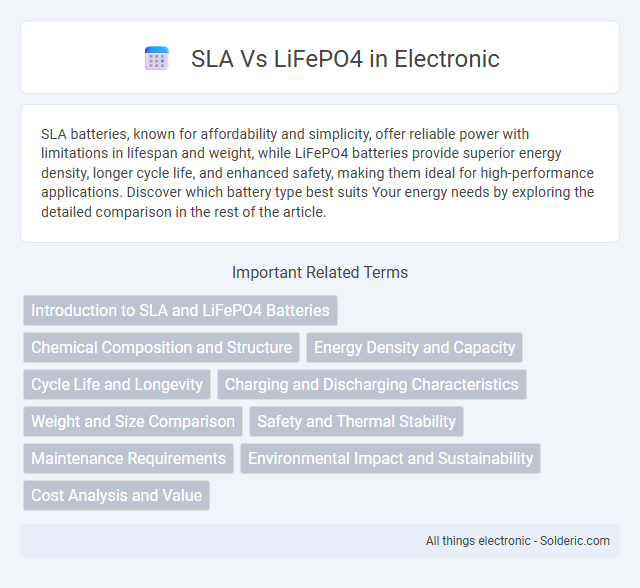SLA batteries, known for affordability and simplicity, offer reliable power with limitations in lifespan and weight, while LiFePO4 batteries provide superior energy density, longer cycle life, and enhanced safety, making them ideal for high-performance applications. Discover which battery type best suits Your energy needs by exploring the detailed comparison in the rest of the article.
Comparison Table
| Feature | SLA (Sealed Lead Acid) | LiFePO4 (Lithium Iron Phosphate) |
|---|---|---|
| Energy Density | 30-50 Wh/kg | 90-120 Wh/kg |
| Cycle Life | 300-500 cycles | 2000-5000 cycles |
| Weight | Heavy | Lightweight |
| Charge Time | 8-12 hours | 2-4 hours |
| Maintenance | Requires periodic checks | Low maintenance |
| Cost | Lower upfront cost | Higher upfront cost |
| Safety | Risk of acid leaks | Stable chemistry, safer |
| Temperature Tolerance | Works well in moderate temps | Better high-temp performance |
| Self-discharge Rate | Higher (3-5% per month) | Lower (1-2% per month) |
Introduction to SLA and LiFePO4 Batteries
Sealed Lead Acid (SLA) batteries are commonly used for backup power due to their affordability and reliable energy storage, but they tend to have lower energy density and shorter lifespan compared to lithium iron phosphate (LiFePO4) batteries. LiFePO4 batteries offer superior cycle life, enhanced safety characteristics, and higher efficiency, making them ideal for applications requiring long-term, stable power. When choosing between SLA and LiFePO4, your decision should consider factors like weight, maintenance needs, and overall cost of ownership.
Chemical Composition and Structure
SLA (Sealed Lead Acid) batteries utilize lead dioxide (PbO2) as the positive electrode and sponge lead (Pb) as the negative electrode, with sulfuric acid (H2SO4) serving as the electrolyte in a gel or absorbed glass mat form. LiFePO4 (Lithium Iron Phosphate) batteries feature a cathode composed of lithium iron phosphate (LiFePO4), an anode typically made of graphite, and an organic electrolyte containing lithium salts. The crystal structure of LiFePO4 provides greater thermal stability and longer cycle life compared to the heavy, dense lead plates and liquid electrolyte found in SLA batteries.
Energy Density and Capacity
LiFePO4 batteries offer significantly higher energy density compared to SLA batteries, typically around 90-160 Wh/kg versus 30-50 Wh/kg for SLA. This higher energy density translates to greater capacity in a smaller, lighter form factor, making LiFePO4 ideal for applications requiring longer runtimes and space efficiency. Your choice of battery can greatly enhance overall performance by prioritizing LiFePO4 for superior energy storage and consistent capacity over time.
Cycle Life and Longevity
LiFePO4 batteries offer significantly higher cycle life, often exceeding 2,000 to 5,000 charge cycles compared to SLA batteries' typical 300 to 500 cycles. This extended longevity means LiFePO4 batteries maintain capacity longer, reducing replacement frequency and overall maintenance costs. Your investment in LiFePO4 technology ensures more reliable, durable energy storage for demanding applications.
Charging and Discharging Characteristics
SLA batteries have slower charging rates and higher internal resistance, which limits their discharge capacity and cycle life compared to LiFePO4 batteries. LiFePO4 batteries support faster charging and discharging with stable voltage output, making them ideal for high-performance applications requiring longevity and efficiency. Your choice depends on whether you prioritize cost-effectiveness or superior charge-discharge performance.
Weight and Size Comparison
LiFePO4 batteries are significantly lighter and more compact than traditional SLA batteries, offering up to 70% weight reduction for the same capacity. Their high energy density allows your devices or systems to be smaller and easier to handle, making them ideal for applications where space and weight are critical factors. Choosing LiFePO4 improves portability and installation flexibility without sacrificing power or longevity.
Safety and Thermal Stability
LiFePO4 batteries offer superior safety and thermal stability compared to SLA batteries, as they are less prone to thermal runaway and overheating under stress or high temperatures. SLA batteries can release hazardous gases and risk swelling or leakage when overcharged or exposed to heat, posing safety concerns. Your choice of LiFePO4 enhances performance reliability and reduces fire hazards in demanding applications.
Maintenance Requirements
Sealed Lead Acid (SLA) batteries demand regular maintenance, including periodic water refilling and monitoring for corrosion to ensure optimal performance. LiFePO4 batteries feature low maintenance needs, as they do not require watering and have enhanced thermal stability, reducing the risk of damage. Choosing LiFePO4 can significantly lower your maintenance time and costs while improving reliability and battery lifespan.
Environmental Impact and Sustainability
LiFePO4 batteries outperform SLA (Sealed Lead Acid) in environmental impact and sustainability due to their longer lifespan, higher energy efficiency, and non-toxic, recyclable materials. Your choice of LiFePO4 reduces hazardous waste and lowers carbon emissions during production and disposal compared to SLA batteries containing lead and corrosive acid. This makes LiFePO4 a more eco-friendly and sustainable energy storage solution for both residential and commercial applications.
Cost Analysis and Value
LiFePO4 batteries offer a higher upfront cost compared to SLA batteries but deliver superior long-term value due to longer cycle life and reduced maintenance expenses. Their enhanced energy density and safety features justify the investment for applications requiring reliability and durability. You save significantly on replacement and operational costs over the battery's lifespan, making LiFePO4 a cost-effective choice despite initial price differences.
SLA vs LiFePO4 Infographic

 solderic.com
solderic.com